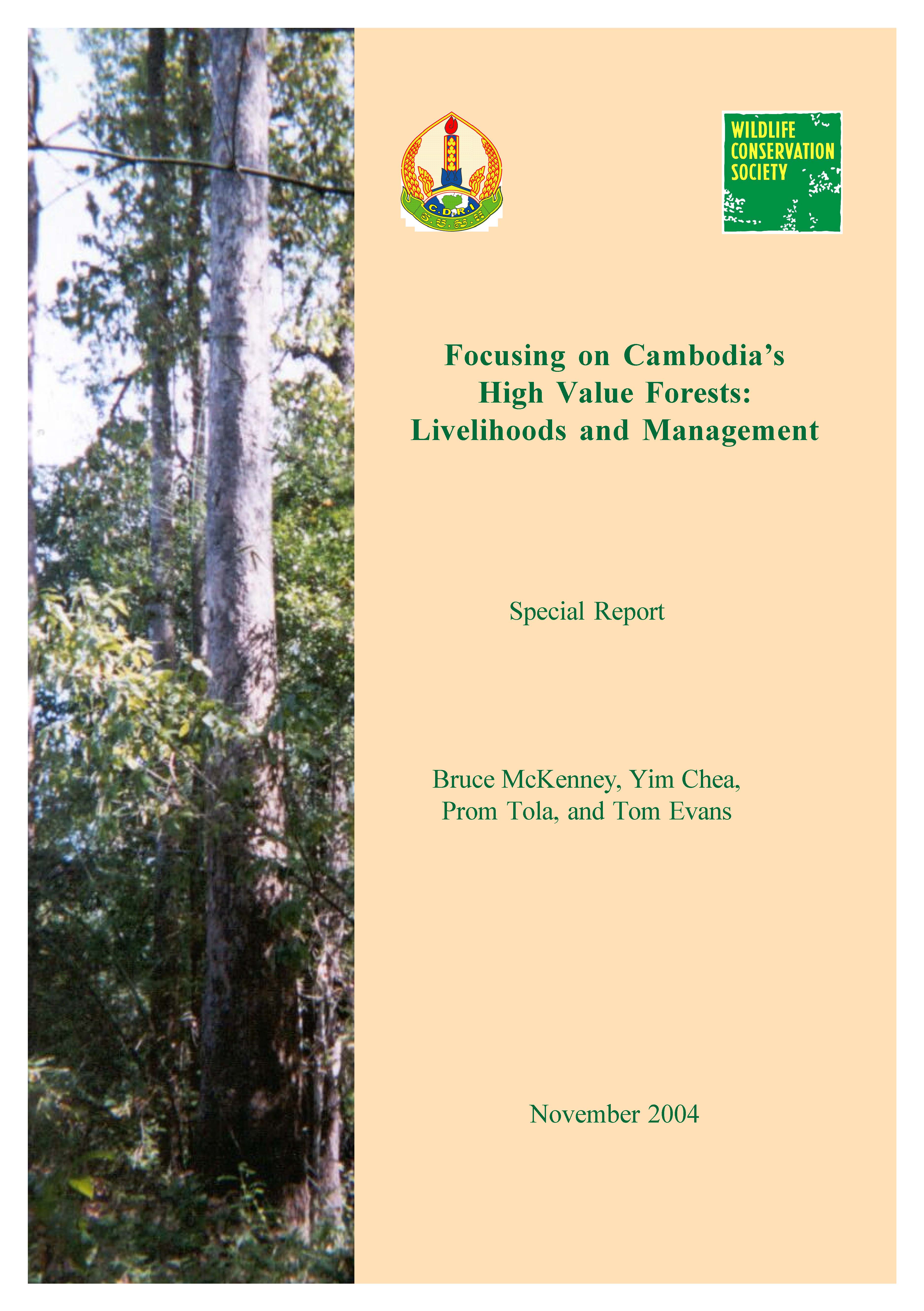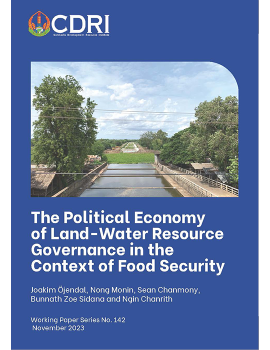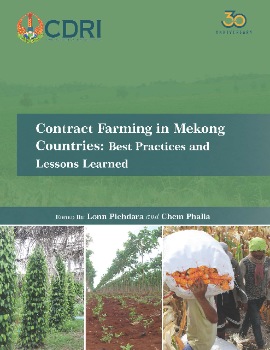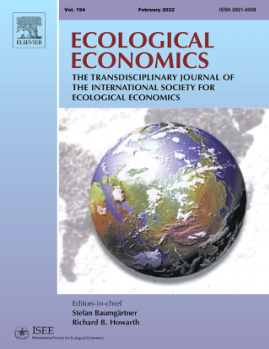
Focusing on Cambodia’s High Value Forests: Livelihoods and Management
Abstract/Summary
With logging operations generally focused on timber “mining”, and royalty collection ineffective, forest management in Cambodia has yet to deliver the economic, conservation, and rural development benefits envisioned. Rather, the management approach in production forests has tended to marginalise local forest users and producers. Based on experiences in Cambodia and elsewhere in the region, continuation of the current commercial forestry model will result in further forest losses with little revenue generated for government. It will not lead to poverty reduction and rural development. Indeed, findings of this study suggest some commercial operations are moving villages in HVF areas further into poverty, not out of it.
Clear policy direction on priorities for management of high value (production) forests is needed. Analysis of management scenarios makes clear that short-term, direct economic rents are substantially higher under conventional logging, but it matters greatly how these rents are distributed. At present, weaknesses in royalty collection mean that the national government captures only a small fraction of timber rents. Most of the timber windfall appears to be captured by logging operations, powerful actors, and a variety of informal fee takers. Meanwhile, as this study illustrates, villagers in HVF areas are often made poorer. And most of these households are already living below the poverty line. With this in mind, a number of recommendations are highlighted below. These recommendations are based on the assumption that the most significant sites for biodiversity conservation will remain in protected areas closed to logging. With this safeguard, significant areas of HVF would still be available for other kinds of management.
1. Make poverty reduction a higher priority of HVF management.
For all the focus on the need for poverty reduction in Cambodia, there is little evidence that commercial management of HVFs is contributing much in this regard, despite HVFs being one of Cambodia’s chief national assets. In the absence of an effectively enforced legal framework, the current strategy of encouraging commercial timber operations to become responsible forest managers appears doomed to failure due to the tremendous financial incentives against it – scenario analysis suggests rents are 6-10 times higher under “cut and run” logging compared to sustainable forest management. If Cambodia is to harness its HVF resources for poverty reduction and rural development, a greater effort is needed to explore the potential of “commercial” community forestry – local forest management that involves commercial activities including modest but sustainable timber harvests. Such an approach could provide substantial revenue for local development and a steady flow of royalties for national accounts as well. Moreover, community forestry can provide villagers with greater security over the forest resources that support nearly half of their household income.
2. Improve forest management targeting, focusing first on HVFs under threat.
With limited resources available for forest management, it is important to identify clear management priorities, taking into account current value, clearance pressures and potential value of other land uses. Maps presented in this study illustrate the correlation between forest loss/disturbance and logging, (logging) roads, soil quality, and new villages in Cambodia. Forest landscapes under multiple threats are most likely to be cleared next. Due to the threat of resource loss, these are the landscapes where villagers are most likely to be motivated to establish community management. The goal of a targeting exercise would be to identify and designate a set of such forest landscapes as management priorities (e.g., HVFs with productive soil areas nearby to villages and inappropriate for conversion). To identify HVF areas specifically for community management, targeting should begin with the 2,000 Cambodian villages located within 5 km of evergreen and semi-evergreen forests, followed by an assessment of other variables (logging operations, roads, productive soils) correlated with forest loss.
3. Prohibit commercial logging in areas of forest where resin trees represent a high proportion of standing commercial timber.
In the HVF areas studied, resin is the most significant forest product for household income. It also plays an important role in reducing the vulnerability of households to crises. Although the harvest of resin trees is prohibited under Article 29 of the Forestry Law, this may be difficult to enforce in forest areas where resin trees make up a high proportion of commercial standing timber. For instance, this study finds that resin trees represent about half the volume and rent of standing commercial timber in a sampled area of one concession, and data are presented to suggest that this is true more widely in Cambodian HVFs. Given the weaknesses of enforcement, and the enormous financial incentives to harvest resin trees, approving commercial logging plans in areas such as these will entail a very great risk of serious impacts on the livelihods of the tapping communities. Detailed mapping of areas where tapped resin trees represent a high proportion of standing timber should be undertaken, and such areas should be excluded from commercial logging for the foreseeable future, until it is sure that safeguards on the field operations of concessionaires and sub-contractors can be adequately enforced. Depending on the threshold set, such areas are likely to cover a high proportion of some concessions (including two of the three sites studied here), and may make their commercial viability doubtful.
4a. Pilot “commercial” community forestry for villages near HVF areas.
Forest products account for nearly half of household income in each of the three HVF areas studied, and these resources have the potential to contribute even more under “commercial” community forestry. Although there are numerous challenges to establishing community forestry, it must also be recognised that the impetus for greater village control of forest resources is here to stay (and consistent with Cambodia’s broader efforts toward decentralisation). Three elements that will likely be necessary for successful development of community forestry in HVFs are: (1) a clear focus on local economic benefits; (2) greater emphasis on identifying community forestry “patrons” who can ensure tenure security and enforcement and (3) safeguards to prevent 'cut and run' logging, overhunting and so on by the communities. It is recommended that these challenges should be addressed in a series of pilots to prepare the way for wider implementation.
4b. Given the timber rents involved, target “commercial” community forestry pilots in HVF areas where indications of “political will” for it are strongest.
This study finds enormous incentives for “cut and run” logging. Capacity-building efforts and technical guidance (e.g., harvesting guidelines) do not change these incentives. Indeed, without genuine political will and strong enforcement, “cut and run” practices can be expected to continue (and even with these elements, such logging may be difficult to stop). In assessing political will for community forestry, the following indicators deserve consideration: (1) Who “owns” the initiative? (2) How much effort is being taken to understand community forestry development challenges? (3) Is the pursuit of community forestry a long-term programme or a one-shot symbolic gesture? (4) What efforts are being taken to mobilise key stakeholders, especially villagers in HVF areas? (5) Are meaningful sanctions being imposed against illegal activities in (planned) community forestry areas?



